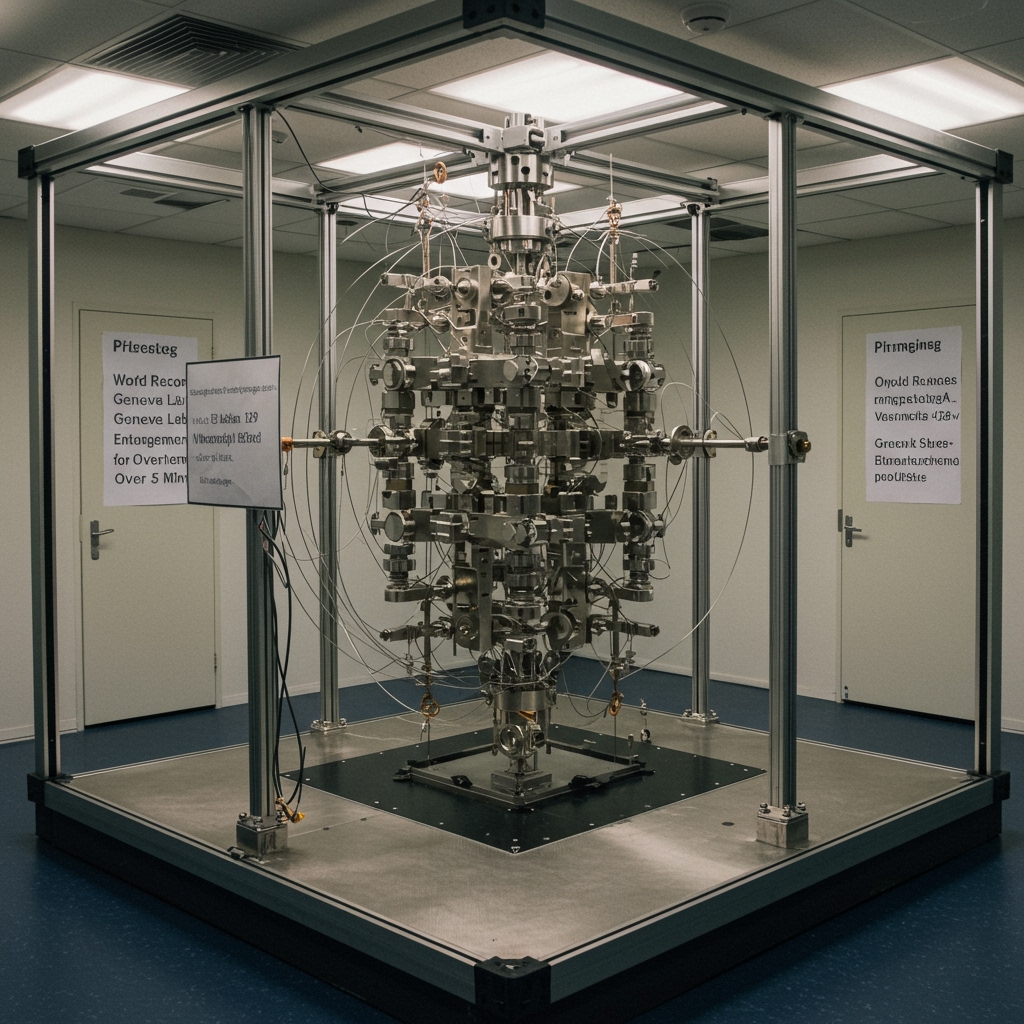Quantum Computing Milestone in Geneva
Geneva, Switzerland – The European Center for Quantum Research (ECQR), a leading institution at the forefront of quantum science, announced on February 18, 2025, a significant breakthrough poised to accelerate the development of practical quantum computers. Scientists at the Geneva-based lab have successfully achieved stable entanglement of a record-breaking 128 quantum bits (qubits), maintaining this complex quantum state for an unprecedented duration exceeding five minutes. This accomplishment represents a new world record for both the number of entangled qubits and the longevity of their stable entanglement, pushing the boundaries of what was previously thought possible in the field.
Pushing the Limits of Qubit Stability
Quantum entanglement, a phenomenon where two or more qubits become interconnected such that the state of one instantly influences the state of others, regardless of the distance between them, is a fundamental resource for quantum computing. However, maintaining this fragile state, known as coherence, is one of the primary technical hurdles in building large-scale, functional quantum processors. Qubits are highly susceptible to environmental interference, such as temperature fluctuations or electromagnetic noise, which can cause them to lose their quantum properties – a process called decoherence.
The ECQR team’s achievement is particularly noteworthy because it scales up stable entanglement to 128 qubits, a considerable leap from previous records, which typically involved far fewer qubits for sustained periods. Furthermore, extending the coherence time to over five minutes for such a large entangled system is a critical step towards performing complex quantum computations that require longer operation times. Previously, coherence times for multi-qubit systems of this size were measured in milliseconds or microseconds, making sustained computation exceedingly difficult.
Novel Architecture Unlocks New Potential
The success, detailed in a comprehensive research paper that has been submitted to the prestigious journal Nature Physics, is attributed to the development of a novel superconducting circuit architecture. While specific technical details of the architecture are under peer review, the ECQR researchers indicated that the design incorporates innovative methods for isolating the qubits from environmental noise and enhancing the connectivity and control necessary for entangling a large number of these delicate quantum units simultaneously. Superconducting circuits are one of the leading platforms for building quantum computers, known for their scalability and potential for high fidelity operations when cooled to near absolute zero temperatures. The new architecture appears to have significantly improved key performance metrics for this platform.
The Path Towards Fault Tolerance
This breakthrough is expected to substantially accelerate the development of fault-tolerant quantum processors. Fault tolerance is crucial for building powerful quantum computers capable of tackling meaningful problems. Due to the inherent fragility of qubits and the high error rates in current quantum operations, computation errors accumulate rapidly. Fault-tolerant designs incorporate sophisticated quantum error correction codes, which require a large number of physical qubits to encode and protect logical qubits (the effective computational units). Achieving stable entanglement across 128 physical qubits for an extended duration demonstrates the potential to build the foundational blocks needed for these complex error correction schemes.
The ability to reliably entangle and maintain the state of a larger number of qubits for longer periods directly contributes to the feasibility of implementing error correction, reducing the effective error rate, and enabling much longer quantum algorithms to be executed successfully. This moves the field closer to building systems where errors can be detected and corrected faster than they occur, a hallmark of true fault-tolerant quantum computation.
Paving the Way for Intractable Problems
The implications of this ECQR breakthrough extend beyond fundamental research. Experts in the field believe that this kind of advancement could pave the way for solving complex problems currently intractable for even the most powerful supercomputers within the next five years. Problems such as discovering new pharmaceuticals and materials, optimizing logistical networks on a global scale, breaking modern encryption methods, and performing highly complex financial modeling require computational power that grows exponentially with the size of the problem.
Classical supercomputers, despite their immense power, are limited by the fundamental physics of classical bits (0s and 1s). Quantum computers, leveraging superposition and entanglement, offer a fundamentally different approach to computation that can explore vast numbers of possibilities simultaneously, making certain types of problems solvable exponentially faster.
The ability to reliably manipulate and maintain the state of 128 entangled qubits for minutes represents a significant step towards building systems capable of running the complex algorithms needed for these applications. While a fully fault-tolerant, universal quantum computer is still some years away, milestones like the one achieved by the ECQR team in Geneva demonstrate that the progress in scaling and stabilizing quantum systems is accelerating, bringing the era of practical quantum advantage closer into view.





